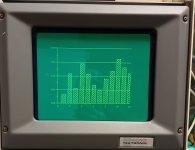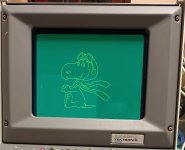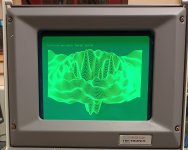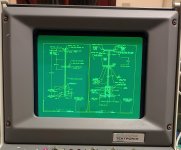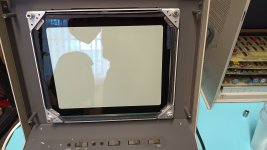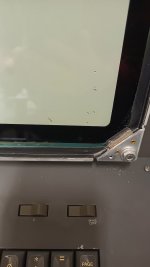Upcoming Events:
| VCF West | Aug 01 - 02 2025, | CHM, Mountain View, CA |
| VCF Midwest | Sep 13 - 14 2025, | Schaumburg, IL |
| VCF Montreal | Jan 24 - 25, 2026, | RMC Saint Jean, Montreal, Canada |
| VCF SoCal | Feb 14 - 15, 2026, | Hotel Fera, Orange CA |
| VCF Southwest | May 29 - 31, 2026, | Westin Dallas Fort Worth Airport |
| VCF Southeast | June, 2026 | Atlanta, GA |
-
Please review our updated Terms and Rules here
You are using an out of date browser. It may not display this or other websites correctly.
You should upgrade or use an alternative browser.
You should upgrade or use an alternative browser.
Tektronix 4010 restoration
- Thread starter thunter0512
- Start date
thunter0512
Veteran Member
nikola-wan
Veteran Member
And your repair was successful??
thunter0512
Veteran Member
Yes, I would call it successful. The Tek 4010 is now fully working.And your repair was successful??
Rotating the CRT by 180 degrees made the more heavily used left side of the screen better. In an ideal world it would be nice to find a replacement CRT, but the way it is now is good enough.
I am now waiting for parts from Mouser to replace some of the parts which I substituted. While the substitutes work, they are not perfect.
The next steps will deal with corrosion of the pedestal and screws, finding replacements for the missing screws, re-chrome the stand and possibly replacing the green safety glass with a matching acrylic sheet.
thunter0512
Veteran Member
I had a closer look at those photos on Reddit. I don't think the phosphor coating is gone, but the entire CRT is missing and replaced by a glass plate to cover the hole.[offtopic alert, though I am following this thread with interest]
@daver2 , you seem like the kind of person who might have a list of tantalum bead capacitor values for 4010-series terminals and 405x-series computers... I have a 4006 whose HV and Z-axis board has popped a tantalum or two, and a 4051 that I haven't dared power up yet. Is there a handful of values used in these machines that I could buy in bulk --- that way I can replace failures one by one, or perhaps replace every capacitor in one fell swoop? (I'm not sure what would be wisest.)
Slightly more related, a friend sent me this Reddit thread where a mysterious catastrophe has attacked the display: the entire coating of the screen is gone. It's a window now. I sent it to some folks at the VintageTEK museum and their guess is that the seal between the CRT bell and the faceplate failed: this caused a gust of wind to sweep the coating completely away. (By contrast, a vacuum failure at the neck usually focuses a blast at the centre of the screen, which creates a kind of "splat" scour pattern in images I've seen.
stepleton
Veteran Member
Not so, apparently. I shared the image with some folks at the VintageTEK museum, who identified some of the DVBST components (collimating anodes, flood guns, etc.) in the photo. They're about as mystified as the rest of us, but their best guess is that the leak occurred when the faceplate separated from the CRT bell around the edge, causing a laminar gust across the CRT and thus the complete scour of the phosphor + ITO coating. I'm still sceptical, but what we see is the real CRT internals, according to experts.I don't think the phosphor coating is gone, but the entire CRT is missing and replaced by a glass plate to cover the hole.
thunter0512
Veteran Member
I had to repair some of the Tek 4010 faults using (sometimes barely adequate) substitutions available locally.
Specifically the high-voltage caps, the diode matrix and glow-lights.
Once the 4010 was fully operational I ordered the correct parts from various suppliers.
I have recently replaced the "hacks" with the correct parts and the terminal is working really well.
Additionally I have painted the originally very rusty and peeling chrome coated steel base black.
Getting it re-chromed would have cost me A$400 which seemed outrageously expensive.
The other two quotes I asked for came back with "sorry we cannot help you with this".
Oh well I think black looks better anyway.
I kept all (most?) of the old components I had to replace (click on the photo to see full size):
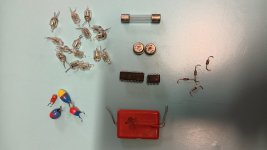
Here is the final picture of the fully functional Tek 4010 (click on the photo to see full size):

Some future improvements will be repainting the grey fascia surrounding the keyboard and the off-white top cover of the terminal.
Specifically the high-voltage caps, the diode matrix and glow-lights.
Once the 4010 was fully operational I ordered the correct parts from various suppliers.
I have recently replaced the "hacks" with the correct parts and the terminal is working really well.
Additionally I have painted the originally very rusty and peeling chrome coated steel base black.
Getting it re-chromed would have cost me A$400 which seemed outrageously expensive.
The other two quotes I asked for came back with "sorry we cannot help you with this".
Oh well I think black looks better anyway.
I kept all (most?) of the old components I had to replace (click on the photo to see full size):

Here is the final picture of the fully functional Tek 4010 (click on the photo to see full size):

Some future improvements will be repainting the grey fascia surrounding the keyboard and the off-white top cover of the terminal.
Last edited:
nikola-wan
Veteran Member
Congratulations - great restoration!

